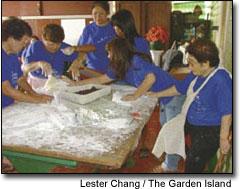HANAMA’ULU — More than 40 members and friends of the Mamura ‘ohana gathered in Hanama’ulu yesterday to honor a Japanese family tradition started in 1924. As part of a Japanese new year’s tradition, family members and friends pounded mochi and
HANAMA’ULU — More than 40 members and friends of the Mamura ‘ohana gathered in Hanama’ulu yesterday to honor a Japanese family tradition started in 1924.
As part of a Japanese new year’s tradition, family members and friends pounded mochi and made mochi cakes at the home of Fujiko Mamura, and came together to celebrate and strengthen family ties that span several generations.
Family members came from Germany, Washington, D.C., and O’ahu, to share the experience of men who steamed and kneaded cooked sweet rice into fine-textured dough, while the women made mochi cakes with adzuki bean paste.
Special foods like mochi play a key role in new year festivities in Japan. The mochi-pounding event had special meeting for members of the Mamura clan, because the practice had been suspended for five years, due to older folks of the clan passing on, and diminishing interest from the younger members, said Clare Mamura, 21.
The Mamura clan members distinguish themselves from many Japanese families on Kaua’i who made mochi cakes in preparation for the coming of the new year.
For convenience, many families use electrically-run, mochimaking machines, that steam and knead the dough, before mochi pastries are made.
The Mamura clan members utilize the traditional method, making mochi in the way it has been made for centuries in Japan, with their hands.
Men used kines, or mallets made with pieces of hau (Hibiscus tiliaceus) wood, to pound the rice that was placed in a stone bowl, which is at least 80 years old and is like a family heirloom for Fujiko Mamura, the keeper of the stone.
Family members preferred to do it this way because the mochi delicacies stay fresher longer than the ones made by machine.
Yesterday, Fujiko Mamura’s carport was turned into an assembly line, all for the purpose of making the perfect mochi pastries.
Mamura said six families each brought 10 pounds of sweet rice they had soaked in water the night before. In all, a total of 60 pounds of mochi would be cooked and fashioned into mochi cakes that could be eaten fresh or refrigerated for consumption another day.
Mounds of rice were put into wooden boxes that sat on top of a gas-powered stove.
To ensure the sweet rice cooked properly, the rice was spread evenly on top of a mat within the box.
A wooden top was put on the top of the box, and its sides were sealed with wet towels as well, to ensure the even cooking of the rice.
Then the rice was put in the stone bowl that was carved out of a rock by a stone-carver in East Kaua’i for Tokutaro Mamura at least 80 years ago.
Alex Zamora of Honolulu, Rolando Dongon of O’ahu, and Jamie Matsumura of Lihu’e, rhythmically pounded the mochi into a soft-textured dough, taking turns pounding the mochi.
They periodically took a break to shave the edges of the kines to remove splinters, which came from the kines periodically banging the edge of the stone. If the kines aren’t shaved, the splinters could get into the mochi.
Eight to 10 pounds of sweet rice could be pounded into a soft dough in about 15 minutes.
As the dough is pounded into the preferred texture, two of the ponders move away, leaving only one ponder to finish the work. A fourth member of the mochi-pounding team pushes the rice to the center of the stone to ensure the rice is evenly pounded.
The finished product is a glutinous mass that is sent to the women to turn into the mochi cakes.
Women don’t pound the rice because that task has been traditionally carried out by men in male-dominated Japan, according to Franklin Pang, a family member.
Attending the mochi-making event on Kaua’i has been a yearly tradition for Pang, a Honolulu businessman and family member, for 39 years.
“My inlaws told me that pounding mochi brings good luck,” he said. “I have good luck and I come every year.”
Pang is married to Jane Mamura Pang, the daughter of Ayako Hirota, 93 of Lihu’e, who is the daughter of Tokutaro and Owari Mamura.
This year’s event came about due to the energy of a new generation of celebrants, 21-year-old Clare Mamura, 25-year-old Maya Mamura, both Honolulu residents, and Melissa Mamura, a 20-something-year-old resident of Washington, D.C., all sisters, and Naomi Rombaoa, a resident of Honolulu.
Fujiko Mamura also had a special reason to revive the tradition for the first time in five years. Her son, Nathan Mamura, a West Point graduate, a retired Army major and now a civilian working for the Army in Heidelberg, Germany, came home for the celebration.
For some, the occasion was to pay honor and respect to the patriarch and matriarch of the Mamura clan, Tokutaro and Owari Mamura.
Tokutaro Mamura came to Hawai’i in 1900, and his wife came to the islands in 1910. Both were from Kumamoto prefecture in southern Japan.
In his lifetime, Tokutaro Mamura worked as a cook for a family in Australia and, later, as a luna (supervisor) for Lihue Plantation, before retiring.
“He would be happy to know we have carried on his tradition,” said one family member. “And we are going to do it again next year.”


